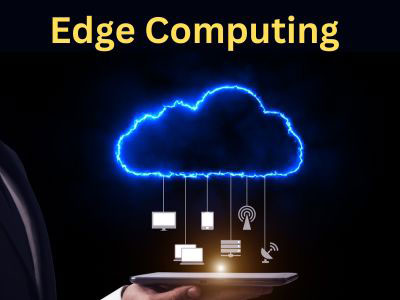Key Takeaway
In 2025, cutting-edge technologies will include AI-driven automation, quantum computing, 6G networks, and advanced edge computing. These technologies will revolutionize industries by enabling real-time decision-making, ultra-fast communication, and secure data processing.
Other notable innovations include augmented reality (AR), biotechnology breakthroughs, and advancements in renewable energy storage. Together, these technologies will drive the next wave of digital transformation.
Edge Computing in the Era of 5G and Beyond
The rollout of 5G networks is set to revolutionize edge computing, offering unprecedented speed, low latency, and massive connectivity. This next-generation network plays a critical role in enabling real-time processing and decision-making at the edge, making it the perfect companion for edge computing applications across industries.
5G provides ultra-low latency, meaning the delay in transmitting data is reduced to milliseconds. This is crucial for edge computing, where real-time data processing and decision-making are vital. In sectors like autonomous vehicles, healthcare, and smart manufacturing, any delay in communication can be costly and dangerous. With 5G’s high-speed capabilities, edge devices can quickly analyze data and take immediate action without waiting for data to travel to the cloud and back.
Additionally, 5G networks support massive device connectivity, enabling the seamless integration of millions of IoT devices in a smart city or industrial setting. Edge computing can process the data generated by these devices locally, ensuring that only the most relevant data is transmitted to the cloud for further analysis. This reduces bandwidth usage and helps prevent network congestion, which is especially important in areas with dense device networks.
Another benefit of 5G and edge computing is enhanced network slicing, which allows dedicated virtual networks to be created for specific use cases. This capability ensures that critical applications, like emergency response systems or industrial automation, receive the necessary bandwidth and reliability without interference from other less-critical data.
Looking ahead, the combination of 5G and edge computing will continue to drive innovation. Technologies like augmented reality (AR), virtual reality (VR), and smart grids will benefit from 5G’s high speeds and edge computing’s ability to process data locally, enabling seamless, immersive experiences and more efficient resource management.

Emerging Applications of AI at the Edge
As edge computing continues to evolve, the integration of artificial intelligence (AI) is unlocking new and exciting applications across various industries. AI algorithms deployed at the edge enable devices to make decisions in real-time, analyze vast amounts of data, and improve performance without the need to send data to centralized cloud servers.
In the healthcare industry, AI-powered edge devices can analyze patient data from wearables and medical devices, such as heart rate monitors and glucose sensors, to provide real-time health insights. These devices can immediately alert healthcare providers if a patient’s condition worsens, allowing for timely interventions.
In autonomous vehicles, AI at the edge processes data from sensors, cameras, and radar systems to make split-second decisions about navigation, safety, and obstacle avoidance. This reduces the reliance on cloud servers for decision-making, enabling faster reactions and improving safety.
The retail industry is also benefiting from AI at the edge. Smart cameras and sensors can track customer behavior, analyze preferences, and optimize store layouts or inventory levels. These insights are processed locally, ensuring real-time actions without delays, such as adjusting digital signage or pricing based on customer behavior.
Smart cities are leveraging AI at the edge for traffic management, waste management, and public safety. AI-powered cameras and sensors at the edge analyze traffic patterns, manage parking spaces, and monitor air quality, providing cities with the ability to make immediate decisions based on real-time data.
Advancements in Edge Hardware for IoT Devices
Edge hardware is evolving rapidly to meet the growing demands of IoT applications.
In 2025, new-generation processors and chips designed for edge computing will dominate the market. These devices will feature improved power efficiency, enhanced processing capabilities, and compact designs, making them ideal for IoT applications. Low-power, high-performance edge devices will enable continuous operations, even in remote or resource-constrained environments.
For example, agricultural IoT systems using edge devices will monitor soil conditions and weather patterns in real-time, optimizing resource usage. Similarly, smart home devices will become more responsive and energy-efficient, enhancing the user experience. These hardware advancements will solidify the role of edge computing as the backbone of IoT ecosystems.
The Rise of Autonomous Systems with Edge Computing
Edge computing is a key enabler of autonomous systems, providing the computational power needed for independence and adaptability.
By 2025, autonomous vehicles, drones, and robots will rely heavily on edge computing to process data locally. This local processing ensures rapid decision-making, which is critical for applications like navigation, obstacle avoidance, and machine collaboration. In warehouses, autonomous robots powered by edge computing will streamline operations, improving efficiency and accuracy.
Additionally, drones equipped with edge intelligence will revolutionize fields like agriculture and disaster response by delivering real-time insights and acting autonomously in dynamic environments. The rise of autonomous systems will showcase the indispensable role of edge computing in achieving self-sufficiency and reliability.
Impact of Edge Computing on Smart Cities Development
Smart cities are leveraging edge computing to deliver efficient, real-time services to their residents.
By 2025, edge computing will power a range of urban innovations, from intelligent traffic management systems to energy-efficient smart grids. Localized data processing at the edge ensures that systems can respond instantly to changing conditions, reducing congestion, lowering energy usage, and enhancing public safety.
For example, edge-powered sensors in smart cities can monitor air quality and alert authorities to pollution hotspots in real-time. Similarly, edge-enabled traffic lights can adjust their timings based on vehicle flow, minimizing delays and reducing fuel consumption. These applications will make cities smarter, more sustainable, and more livable.
Conclusion
The innovations shaping 2025—from edge computing and AI to IoT and smart city solutions—are transforming industries and everyday life. With advancements in hardware, the rise of autonomous systems, and the integration of cutting-edge technologies, the future promises efficiency, sustainability, and intelligence like never before.
These trends position edge computing and its allied technologies at the forefront of the next technological revolution.
